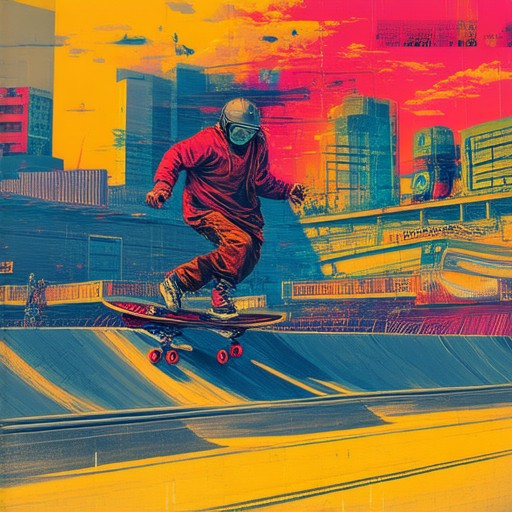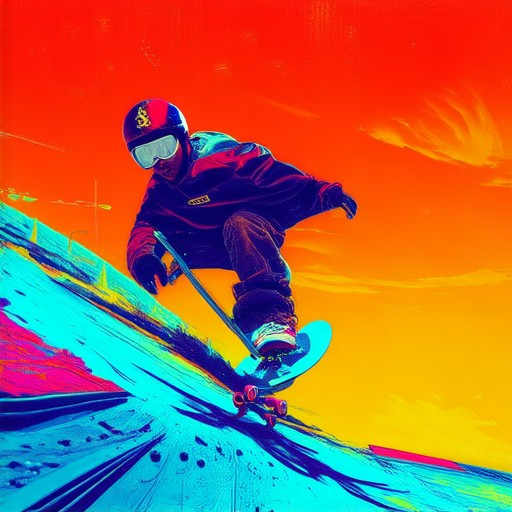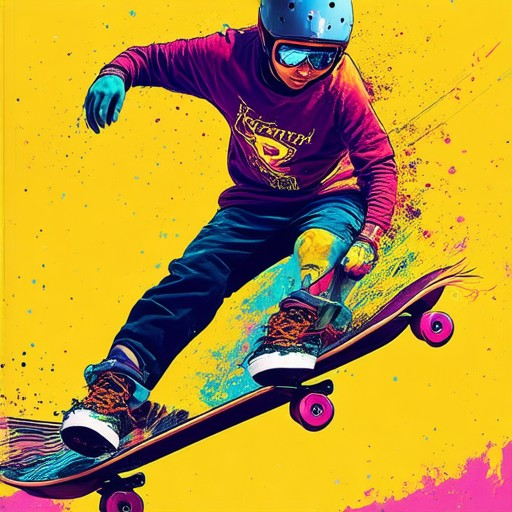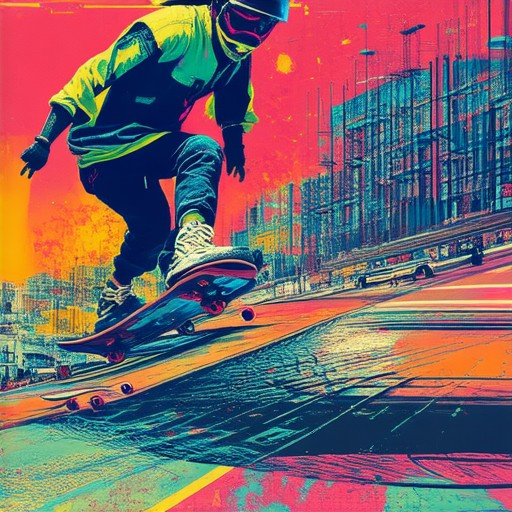Skateboarding has long been a source of inspiration for countless individuals around the world. From its humble beginnings rooted in surf culture and beachside fun to its current status as a globally recognized sport and cultural phenomenon, skateboarding continues to evolve and inspire. Whether you’re a seasoned skateboarder or someone exploring the world of boarding for the first time, the stories behind its creation, the iconic tricks that define it, and the communities it has shaped offer a rich tapestry of history and creativity. This journey from its ancient origins to modern times explores the many facets of skateboarding, including its mental health benefits, iconic tricks like the legendary 900, and its profound cultural impact. Join us as we delve into the vibrant world of skateboarding, uncovering how it shapes lives, fosters connections, and remains a timeless source of inspiration.

What Was Skateboarding Inspired By?
Skateboarding was inspired by the vibrant beach culture of Southern California in the mid-20th century. The primary influence came from surfing, where surfers sought ways to practice their skills on land. In the 1950s and 1960s, surfers began attaching small wheels to wooden boards, creating “land surfboards” that allowed them to mimic the feel of riding waves on dry ground.
The invention of the skateboard quickly gained momentum, with early versions resembling crude versions of today’s modern boards. Surfers and tinkerers experimented with different materials and designs, leading to the creation of the first functional skateboards. Over time, skateboarding evolved into its own unique sport, blending elements of surfing, BMX biking, and creativity.
The Functional Inspiration
- The initial concept of attaching wheels to boards was borrowed from surfboards, enabling surfers to practice their skills when the ocean was flat.
- Early skateboards were simple and functional, designed to mimic the feel of riding waves.
Cultural Impact
- Skateboarding became a part of the counterculture movement of the 1960s, attracting young people who embraced the freedom and creativity of the sport.
- Beachside hangouts and skate parks became hubs for skateboarders to gather and share tricks.
Evolution Beyond Surfing
- While surfing remains a significant influence, skateboarding developed its own identity, incorporating elements from various other sports and cultures.
- The rise of skateboarding competitions and the development of specialized equipment marked its transformation into a global phenomenon.
Historical Context
- The first skateboards were made from wood and metal, reflecting the limited technology of the time.
- As materials improved, so did the design, leading to the creation of lightweight and durable boards.
Modern Day
- Skateboarding continues to evolve, with new technologies and styles emerging regularly.
- It has become a popular recreational activity and a cultural icon, inspiring countless movies, games, and fashion trends.
- Skateboarding’s roots trace back to surf culture in California.
- Early skateboards were adapted from surfboards to allow practice on land.
- The sport quickly grew into its own identity, blending functionality with creativity.
- Today, skateboarding is a global phenomenon with its own competitions and culture.
Kickflip Boards offers a comprehensive guide to everything you need to know about skateboarding, from choosing the right board to mastering tricks. Visit our website for tips, reviews, and resources to enhance your skateboarding experience: Kickflip Boards .
Is Skateboarding Good for ADHD?
Skateboarding has emerged as a unique activity that may offer significant benefits for individuals with ADHD (Attention Deficit Hyperactivity Disorder). Research indicates that skateboarding can positively impact cognitive function, motor skills, and overall symptoms associated with ADHD.
Key Benefits of Skateboarding for ADHD:
- Physical Exercise : Skateboarding is an excellent form of physical activity, which helps in promoting better blood flow to the brain and boosting serotonin levels. This can lead to improved mood and concentration, both of which are often challenging for individuals with ADHD.
- Motor Skills Improvement : The repetitive nature of skateboarding helps in developing and refining motor skills. This can lead to better coordination and balance, which are essential for managing the hyperactive tendencies often seen in ADHD.
- Structured Routine : Skateboarding requires discipline and routine, such as practicing tricks or maintaining board care. This structured approach can help individuals with ADHD develop better organizational and time management skills.
- Social Interaction : Skateboarding sessions often take place in groups, providing opportunities for social interaction. This can reduce feelings of isolation and loneliness, which are common among individuals with ADHD.
- Focus and Concentration : Learning new tricks and mastering maneuvers requires intense focus and concentration. This aspect of skateboarding can help improve attention span and reduce impulsive behaviors.
- Stress Relief : Engaging in physical activities like skateboarding can help release stress and anxiety, which are common emotional challenges faced by individuals with ADHD.
Why Skateboarding Works for ADHD:
The combination of physical exertion, mental focus, and social interaction makes skateboarding a versatile tool for managing ADHD symptoms. Studies have shown that participation in regular skateboarding sessions can lead to noticeable improvements in cognitive function, motor skills, and overall well-being.
Recommended Brands and Resources:
For those interested in starting skateboarding, consider exploring products from reputable brands like Kickflip Boards . Their extensive collection of boards and accessories is perfect for skaters of all levels. Additionally, platforms like Bones Bearings and Element Skateboards offer high-quality products tailored to the needs of skateboarders.
By incorporating skateboarding into a daily routine, individuals with ADHD can enjoy a variety of physical, mental, and emotional benefits that contribute to a more balanced and fulfilling lifestyle.

The 900 Skateboard Trick
The 900-degree skateboard trick is a advanced trick that involves flipping the skateboard 900 degrees. Here’s a breakdown of how to perform it:
- Ollie Setup : Begin with a standard ollie setup, where the board is positioned under your feet at a slight angle.
- Flip Execution : As you pop the nose of the board, swing your legs forward and kick the tail out behind you. The board will spin underneath you, completing a 900-degree rotation.
- Landing : Land softly on your feet, keeping your balance and control.
Pro Tips:
- Practice your ollie technique extensively before attempting the 900-degree flip.
- Focus on your foot placement and body positioning to maintain control during the flip.
- Work on your board control to ensure the board responds accurately to your movements.
This trick requires patience, practice, and a good understanding of skateboard physics. Always prioritize safety and respect the board’s limits when attempting tricks like the 900-degree flip.
For more tips and guides on skateboard tricks, check out our Skateboard Tricks Guide .

Why Did Skateboarding Lose Popularity?
Skateboarding experienced a significant decline in popularity over the years due to various factors affecting its appeal and accessibility. Here’s a breakdown of the key reasons:
- Competition from Other Extreme Sports :
The rise of BMX biking, inline skating, and other action sports introduced alternative ways for individuals to experience thrill and adventure. These sports offered unique experiences that skateboarders could not, leading to a shift in interest towards more diverse extreme sports. - Rising Costs :
Skateboards have become increasingly expensive over the decades. While in the past, a decent board could be purchased for under $100, today they often cost double that. Economic struggles and the high price point have made skateboarding less accessible to many, contributing to its reduced popularity. - Cultural Shifts :
Skateboarding has historically been associated with rebellion and counterculture movements. However, as it became more mainstream, with corporate sponsorships and official teams, it lost some of its edgy appeal. The commercialization diluted the original essence of the sport, turning some enthusiasts away. - Safety Concerns and Regulations :
Skateboarding inherently carries risks, and increased regulations and liability concerns have made organizing events and competitions more challenging. This has somewhat dampened the growth of the sport compared to others with fewer safety concerns. - Technological Advancements in Other Sports :
While skateboarding has seen technological innovations, other sports have embraced newer technologies at a faster rate. This has sometimes made skateboarding seem outdated compared to more advanced equipment and methods used in other extreme sports. - Urbanization Changes :
As cities have expanded, public spaces have become more crowded, and finding suitable spots to skate has become more difficult. This limitation, combined with the challenges of accessing private skate parks, has hindered the ability to attract and retain new skaters.
These factors collectively contributed to skateboarding losing some of its popularity over the years. Despite this, the sport continues to have a dedicated following and remains a significant part of youth culture globally.
Where Was Skateboarding Banned?
Skateboarding has faced bans in various regions around the world, with one notable instance being in Norway. From 1977 to 1989, the possession, utilization, sale, or distribution of skateboards was legally prohibited in Norway.
This ban reflects a historical period where societal attitudes towards skateboarding were less accepting. However, public perception has evolved significantly since then, and skateboarding is now widely recognized and appreciated globally.

Is Tony Hawk a Millionaire?
Tony Hawk is indeed a millionaire and is widely recognized as one of the most successful skateboarders in history. With a net worth exceeding $100 million, Hawk has built a significant fortune through his career in professional skateboarding, endorsements, and various business ventures.
Career Highlights
Tony Hawk began his rise to fame in the 1980s, becoming a pioneer in extreme skateboarding. He won numerous competitions and became a household name, thanks to his innovative tricks and style. His influence extended beyond skateboarding, leading to endorsements with major brands like Nike and Panasonic.
Financial Journey
Despite facing challenges in his professional career, Hawk managed to turn his life around through smart financial decisions. At just 17 years old, he purchased his first house, which he later sold for a substantial profit. This move played a crucial role in helping him stabilize his finances during uncertain times in his career.
Diversified Income Streams
Hawk’s wealth isn’t solely derived from skateboarding. He has ventured into acting, appearing in films like ” Lords of Dogtown” and “Grind,” as well as producing content through his company, Birdhouse Skateboards. He has also invested wisely, further diversifying his income sources.
Entrepreneurial Spirit
Tony Hawk has demonstrated a strong entrepreneurial spirit by launching his own businesses. In addition to Birdhouse Skateboards, he has released his own line of clothing and footwear. These ventures have significantly contributed to his overall net worth.
Competitors and Legacy
While there are other notable skateboarders like Rodney Mullen who have also achieved financial success, Tony Hawk’s legacy stands out due to his impact on the sport and his ability to adapt and thrive in various industries.
Conclusion
Tony Hawk’s journey from a young skateboarder to a millionaire is a testament to his talent, resilience, and business acumen. His story inspires aspiring athletes and entrepreneurs, highlighting the importance of perseverance and adaptability in achieving long-term success.




0 Comments